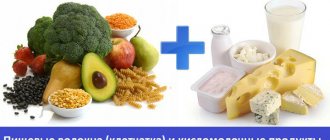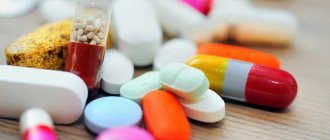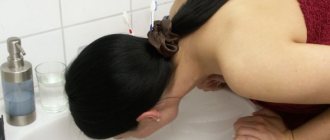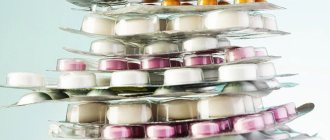dysbacteriosis
digestive problems
treatment of dysbacteriosis
When an infectious-inflammatory process develops, first-line drugs include antibiotics, which not only have a therapeutic effect, but also contribute to the development of intestinal dysbiosis. When the microflora is disturbed after antibiotics , symptoms such as diarrhea, excessive gas formation in the intestinal lumen (flatulence), nausea, bowel disorders in the form of constipation or diarrhea, skin rash, and impaired absorption of substances from food come to the fore. Dysbacteriosis caused by taking antibiotics requires timely and proper treatment. How to restore intestinal microflora after antibiotics will be discussed in detail below.
Intestinal recovery after antibiotic treatment
The intestines suffer greatly from taking antibiotics
A huge number of beneficial microorganisms daily take on the complex processes of assimilation and digestion of food. Moreover, the state of our immunity largely depends on the coordinated work of E. coli colonies in the small intestine.
The breakdown of incoming components of complete nutrition and inhibition of the growth of pathogenic bacteria is the prerogative of lactobacilli. The production of amino acids and vitamins, the breakdown of fats is the responsibility of bifidobacteria.
Taking antibacterial drugs makes the intestinal microflora almost sterile. The consequences of this can be the most unpredictable:
- Irritable bowel syndrome and diarrhea appear.
- Pathogenic strains of bacteria (salmonellosis, dysentery) multiply significantly.
- The level of general immunity decreases.
In order to avoid this, in parallel with the use of antibiotics, it is advisable to take drugs that protect the microflora (Linex, Hilak Forte). If signs of dysbiosis are evident, you need to restore the balance of microflora and follow a special diet. It will help create optimal conditions for the reproduction of the necessary microorganisms.
Foods rich in plant fiber contribute to intestinal restoration. These are fruits and vegetables, with cabbage in first place. In combination with vegetable oil, it will help eliminate pathogenic microorganisms. To populate the intestines with beneficial bacteria, “live” cultures of fermented milk products are needed: kefir, fermented baked milk, yogurt. They can be prepared at home using pharmaceutical preparations Lactobacterin and Bifidumbacterin (2 ampoules per liter) as a starter.
Temporarily you need to give up yeast baked goods, confectionery, tea and coffee. They need to be replaced with juices of fresh fruits and berries, jelly, decoctions of chamomile, sage, and ginger infusion. It is undesirable to use fried, smoked, fatty foods. Instead, it is better to eat porridge, cottage cheese, fresh vegetables and fruits. Several weeks of such a diet, together with the use of drugs prescribed by a doctor to restore microflora, will help the intestines return to health.
Microflora disturbance
Microflora in the intestines can be disrupted for various reasons
There are many reasons why the microflora in the intestines can be disrupted. And depending on what became the provoking factors, the treatment will depend, during which attention is paid not only to the restoration of the flora itself, but also to the elimination of negative factors. The main causes of microflora disturbance include:
- Taking antibiotics, which in 90 percent of cases causes dysbiosis
- Poor nutrition, as a result of which the body does not receive enough fiber and other beneficial substances necessary for normal intestinal function
- Frequent bowel cleansing. Many people periodically, once or twice a week, “cleanse” by taking special medications to soften the stool. But in this case, not only feces are removed from the intestines, but also beneficial bacteria, which are so necessary for normal intestinal function.
- Frequent use of antibacterial agents, which can kill beneficial bacteria Weak immunity, due to which infections and other bacteria will penetrate more into the body, since it is not able to resist them
- Stress, which is the cause of many diseases
- Overfatigue, as a result of which the body adjusts to conserve energy
Treatment will depend on what caused the microflora disturbance, since it is not enough to simply take drugs to improve the microflora. It is also necessary to remove the provoking factor, because otherwise, even if you cure the intestines, but do not stop, for example, eating incorrectly, after a short period of time the problem will return again.
Medicines to help the intestines after poisoning
Drug for restoring intestinal function: Linex
The main drugs for intestinal restoration are probiotics (live cultures of bacteria that replenish colonies of beneficial microorganisms) and prebiotics (substances that supply nutrition to beneficial microbes and work to suppress pathogenic microflora). Probiotics:
- Preparations with monocultures of lactobacilli (Acilact, Biobakton, Lactobacterin).
- Preparations with monocultures of bifidobacteria (Probifor, Bifidumbacterin).
- Preparations with a complex of bifidobacteria and lactobacilli (Florin Forte).
- Preparations with a complex of bifido-lactobacteria and enterococcus (Linex).
- Preparations with bifidobacteria and Escherichia coli (Bifikol).
These products have contraindications: allergies and immune disorders.
Prebiotics: Lactofiltrum, Portalac, Inulin, Duphalac. The advantages of probiotics and prebiotics are combined with drugs such as Bifiform and Hilak Forte. Prebiotics should be prescribed with caution only to those who suffer from diabetes and intestinal obstruction.
When restoring the intestines after poisoning, you should not rush to use pharmaceutical drugs. You need to try to help yourself first by including lactic acid and fermented foods in your diet.
Fermented products
In the times of our ancestors, a significant proportion of the diet consisted of fermented foods. For the winter, sauerkraut was prepared in large quantities, cucumbers and tomatoes were salted in barrels. And this is no coincidence - sauerkraut products (and especially sauerkraut) are of great benefit to our body.
Fermentation is a cooking method based on lactic acid fermentation. Fermented foods contain lactic acid bacteria, which help maintain intestinal microflora. At the same time, lactic acid accumulates in the fermented product, which is secreted by lactic acid bacteria participating in the process and is a natural preservative.
The main thing is to prepare such products using natural fermentation, without adding vinegar and sugar.
Colonoscopy – we relieve the consequences and restore the intestines
Such an informative study as a colonoscopy cannot be replaced by anything in terms of diagnosis. Unfortunately, this intervention in the internal environment of the human body does not pass without consequences. After this procedure, the person being examined may experience:
- intestinal bleeding,
- stomach ache,
- constipation,
- diarrhea,
- flatulence.
Most often, a special diet for recovery is not required; you can switch to a normal diet on the day of the examination. The problem with flatulence, which is explained by the air remaining in the intestines after the examination, is easily solved. It is enough to take 4-5 crushed tablets of activated carbon simultaneously with plenty of water.
What can patients with dysbiosis drink?
If changes are observed in the intestinal microflora, you also need to carefully monitor your diet. You should drink liquid no later than half an hour before meals and no earlier than 2 hours after it.
All alcoholic drinks and carbonated waters are prohibited. It is recommended to limit kvass and sour jelly. Infusions of chamomile and mint, cranberry juice and jelly, and compote based on dried fruits will be useful. You can also supplement your diet with drinks based on bitter herbs. For diarrhea, compotes made from astringent berries, infusions based on pomegranate peels and oak bark are useful. You need to drink still water, preferably mineral water. For carbonated drinks, you must first eliminate the gases. To do this, leave the bottle open for some time.
Recovery with medication
Prescribing medications is the prerogative of the doctor; medications are a help that temporarily replaces the body’s own resources. Most often, probiotics, motor stimulants, and enzymes that promote food digestion are prescribed.
Diet is one of the most important factors in recovery
The importance of diet is enormous!
Its purpose is closely related to how intense the surgical intervention was. The condition after removal of appendicitis and after resection of part of the intestine are strikingly different from each other, as well as the diet for these conditions.
On the first day after surgery, you are not allowed to eat, but on the second or third day you can take liquid food (2-3 spoons). Most often it is broth or fermented milk products such as kefir and yogurt. A few days later they are supplemented with porridge with water or diluted milk, baked apples, pumpkin puree, and wheat bread crackers.
Additionally, medications are taken to stimulate intestinal motility (Duphalac). New products are introduced gradually in order to track the body's reaction to them. During the first month, to stimulate motor skills, it is suggested to add to the diet:
- Fermented milk products: cottage cheese, yogurt with bifidobacteria, kefir, fermented baked milk.
- Boiled meat: rabbit, chicken.
- Cereals: rice, pearl barley, barley, buckwheat, oatmeal, semolina.
- Fruits and vegetables: beets, carrots, apricots, apples, plums.
It is important to eat regularly, in a calm environment, at regular intervals. The volume of food also matters - it does not exceed one glass, or 200 g. It is important to drink enough liquid, at least 2 liters per day. During the first time of restoration of intestinal functions, there may be phenomena such as alternating constipation and diarrhea, nausea and vomiting, and a short-term increase in temperature.
Based on the results of regular hardware examinations (colonoscopy, irigoscopy), the attending physician will correct the diet. With intestinal atony, the main emphasis is on foods rich in fiber, and with a tendency to cramps, on easily digestible foods.
Diagnostics
The presence of dysbiosis caused by taking antibacterial drugs can be determined by characteristic clinical signs. Specific methods for diagnosing this pathological condition include bacterial culture of stool and laboratory analysis for dysbacteriosis. In order to determine dysbiosis of the small intestine, an examination of an aspirate or scraping from the jejunum is performed. Indirect signs of microflora imbalance are determined by performing gas-liquid analysis and biochemical examination of feces.
Supplement to the diet: folk recipes
After consultation with a specialist, the diet can be supplemented with herbal medicinal infusions. It is recommended to combine different plants with each other. Herbal medicine is usually divided into several stages:
- Stage 1 . Plants such as St. John's wort, anise, and coltsfoot are used to help normalize the microflora. Chamomile, blackberry, calamus and other herbs can be used for disinfection.
- Stage 2 . Treatment is aimed at relieving inflammation of the gastrointestinal tract, restoring balance in the body and normalizing digestion. Plants such as chamomile, yarrow, marigold, St. John's wort, etc. are used.
- Stage 3 . To eliminate toxins from the body, flax seeds, leaves and roots of elecampane, angelica, and calamus are used.
- Stage 4 . For diarrhea, it is useful to use astringent components that are contained in oak bark, cinquefoil, and bergenia root. Bird cherry fruits, infusions with burnet root and erect cinquefoil also help.
- Stage 5 . Anise, cumin, and fennel can be used to combat constipation. If there is a large amount of feces that injure the anus, you can use a mixture of buckthorn, milkweed, Alexandria leaf and hogweed.
- Stage 6 . Elecampane, marshmallow, angelica, and flax seeds will help protect the mucous membranes of organs from the negative influence of pathogenic microorganisms.
- Stage 7 . The body needs to be saturated with energy and vitality. For this, infusions of rowan, black currant, rose hips, string, and strawberries can be used. Herbs can be combined with milk sugar. Chamomile will help normalize stools and eliminate intestinal spasms; lactose will help restore microflora. Plantain is useful for diarrhea. For flatulence, you can chew fennel seeds. Another proven remedy for problems with microflora is garlic along with fermented milk products.










